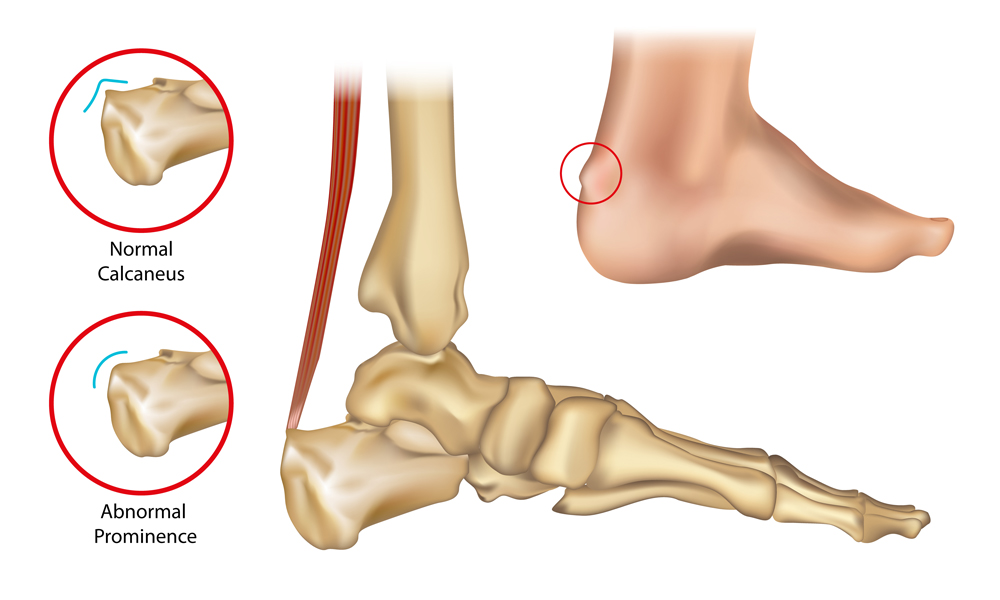- Home
- Retrocalcaneal Bursitis/ Hagelund Deformity
Retrocalcaneal Bursitis/ Hagelund Deformity
What is Retrocalcaneal Bursitis?
It sounds like a mouthful, so let’s break down the term retrocalcaneal bursitis. First, some definitions. Calcaneus is the medical name for the heel bone. It is a large bone that forms the back of the foot.
A bursa is a sac of fluid that provides lubrication, reduces friction, and facilitates movement between different surfaces in the body. There are many bursas present in the body, usually near large joints. Repeated or excessive use of a joint can cause a bursa to become inflamed and irritated.

Symptoms of retrocalcaneal bursitis
The main symptom of retrocalcaneal bursitis is heel pain. The pain is typically located at the back of the heel and occurs especially with walking, running, and jumping. You may experience pain when leaning on your heel, for instance, while sitting with your heels flat on the ground. The pain is sometimes worse when you stand up on your tiptoes, as this places pressure on the heel. The area of the heel may feel tender to touch.
Other symptoms of retrocalcaneal bursitis
- redness
- warmth
- swelling of the skin at the back of the heel
- a crackling sound when bending the foot toward the leg
- discomfort with wearing tight-fitting shoes
BOOK AN APPOINTMENT
You Don't Have To Live With Pain
Dr. Rahul Bade is a specialist Knee & Shoulder Surgeon.
Causes of retrocalcaneal bursitis
Inflammation of the retrocalcaneal bursa is most commonly caused by overuse or repetitive trauma. It can also be aggravated by pressure, for example, from tight-fitting athletic shoes. If you’ve recently started an intense workout regimen (training with uphill runs, for example) and are experiencing heel pain, it could be due to retrocalcaneal bursitis.
One of the risks of retrocalcaneal bursitis is a sudden increase in activity without proper conditioning, which puts stress on the ankle joint. This can lead to excessive friction and repetitive rubbing of the Achilles tendon against the retrocalcaneal bursa, causing inflammation and irritation of the bursa. People who don’t stretch and warm up properly are at higher risk of developing retrocalcaneal bursitis. The condition can also occur in folks with a history of arthritis.
Retrocalcaneal bursitis is sometimes mistaken for another similar condition called Achilles tendonitis, which is an inflammation of the Achilles tendon. If you’re experiencing pain at the back of your heel and treatment for Achilles tendonitis has not helped, you might be suffering from retrocalcaneal bursitis instead.
There is a subtle difference in symptoms. Tenderness from retrocalcaneal bursitis is typically present on the sides of the heel cord. A physician or physiotherapist can determine which of these two conditions is present with the help of a careful examination.
A definitive diagnosis can be made with imaging studies, such as ultrasound, MRI, or CT scan. Remember, you may have both conditions at the same time.
Treatment for retrocalcaneal bursitis
Doctors recommend resting and reducing or avoiding activities that cause pain for a short period. Applying ice to the heel for 15-20 minutes each several times a day during the acute phase of retrocalcaneal bursitis can help ease symptoms. If the pain does not allow you to remain active by walking or running, you should consider alternative means of maintaining strength and fitness, such as swimming and water aerobics.
Besides rest and icing for symptom relief, rehab exercises are an effective treatment for retrocalcaneal bursitis. Gradual stretching of the heel improves flexibility and relieves impingement on the bursa, leading to an improvement in symptoms. Experts recommend a gradual increase in rehab exercises to return to the previous level of functioning, pain-free.


